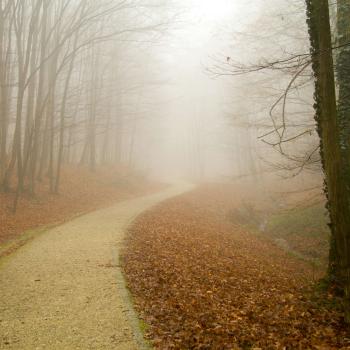When you think of meditation, what image comes to mind? You might picture a person sitting cross-legged on the floor or nestled in a comfortable chair, eyes closed, oblivious to their surroundings. But there’s a technique that takes a very different approach to meditation—because it involves movement and keeping your eyes wide open.
I’m talking about walking meditation. On the Waking Up app, host Sam Harris discusses the two different types of walking practices. One is the super-slow walk, where you move a fraction of an inch at a time, focusing on each subtle movement of your body. It might take you 10 minutes to cross a room (that one’s not for me). But then, there’s another type of walking meditation where you are moving outside at normal speed—and the only one who knows you’re meditating is you.
To start this practice, go outside and get walking. As with regular meditation, you might want to first focus your breath as it enters and leaves your body, in and out, in and out. Then, attempt to clear your mind, finding the empty space between your thoughts. Harris offers this instruction:
Each step is a chance to be fully present, right now, no matter where you’re going. Notice how your balance shifts as you move. Notice the sights and sounds around you. Notice that your body knows exactly how to walk, without any conscious effort from you.
The next thing to do is to take note of how you pay attention to your field of vision. You can view the world as coming toward you, much like you do when you’re driving a car. You receive the objects in your visual field as they come at you. But conversely, you can view yourself as moving forward into the world. Your eyes look for and find the objects in your visual field.
You can toggle or alternate between these two perspectives—the world coming toward you and you going out to the world. According to Harris, it is at the center of these two points you can find the center of your consciousness—or what some call your field of awareness. It can sometimes give you the feeling that awareness is not just locked in your head, but in the words of Loch Kelly is “spacious and pervasive” and extends to the space around you.
One Famous Proponent of Walking: Henry David Thoreau
While Thoreau probably didn’t realize it at the time, over 150 years ago he championed the idea of a walking practice. In 1861, seven years after publishing his landmark Walden, Thoreau wrote a short treatise titled Walking. The author preached the benefits of walking, not for exercise, but to achieve a relaxed state of mind. Thoreau wanted us to both figuratively and literally return to our roots, as he regarded man as “part and parcel of Nature, rather than a member of society.”
In her Brain Pickings newsletter, Maria Popova tells us that Thoreau believed that “the primal act of mobility connects us with our essential wildness, that spring of spiritual vitality methodically dried up by our sedentary civilization.” Thoreau looked at “every walk is a sort of a crusade” and he didn’t so much see it as a way to get in his steps (like we might today), but as a spiritual endeavor. In his lightly edited words:
The walking of which I speak has nothing in it akin to taking exercise, as in the swinging of dumbbells; but walking itself is the enterprise and adventure of the day.
Thoreau’s purpose in walking was distinctly meditative in nature. He walked to clear his head, and escape the pressures of the world around him, as evidenced in this edited passage:
In my afternoon walk I would gladly forget all my morning occupations and my obligations to society. In my walks I would return to my senses. What business have I in the woods, if I am thinking of something out of the woods?
Some see Walking as a Way to Connect with God
In his Daily Meditation newsletter, Richard Rohr often features topics related to the “contemplative call to nature.” In one such newsletter, he featured the author (and virtual abbey owner) Christine Valters Paintner who describes “the ancient contemplative practice of walking or moving slowly through the natural world” and how it is “a way of connecting with God.”
Like Harris, Paintner positions contemplative walking as an alternative to seated meditation. And like a modern-day Thoreau, Paintner sees walking as a way “to cultivate intimacy with Earth and her creatures, and we allow ourselves to fall in love with nature.” In her words:
There is something about getting our bodies out into the world, in close contact with trees, bushes, flowers, squirrels, pigeons, and crows, that can invigorate us and offer us new perspective on life. In the book of Jeremiah, God asks, “Do I not fill heaven and earth?” (Jeremiah 23:24). These walks are times to really experience that truth.
Again, like Thoreau, Paintner does not see walking as being for fitness, though it does not mean you have to walk slowly. She writes that walking contemplatively, means “giving yourself over to the experience…it is walking to immerse yourself in an encounter with whatever is calling you in the moment.”
Here are 6 tips for contemplative walking from Christine Valters Paintner:
- As you begin a contemplative walk, allow a few moments simply to breathe and connect to your heart. Set an intention for this time to be as present as you can to what is happening both within and without.
- Begin walking but see if you can release any expectations or destination. As you walk, imagine that with each step your feet are both blessing the ground and being blessed by it.
- Let your breath be long and slow. Bring your awareness to the earth monastery all around you.
- Notice what draws your attention. Look for what shimmers. Listen for the sounds of life around you.
- Even if you are walking through a city, pay attention to the rustle of the breeze, the caw of crows, or any subtle elements of creation singing their song.
- Pause regularly simply to receive this gift. Breathe it in. Let it have some space in your heart. Then, continue on until something else causes you to stop.














